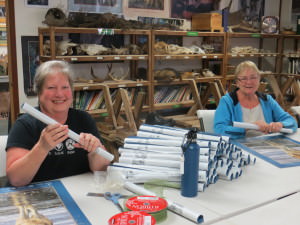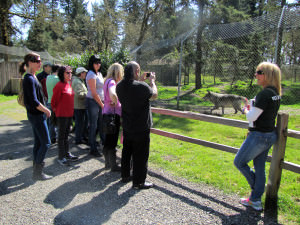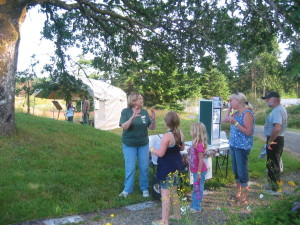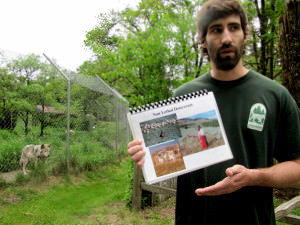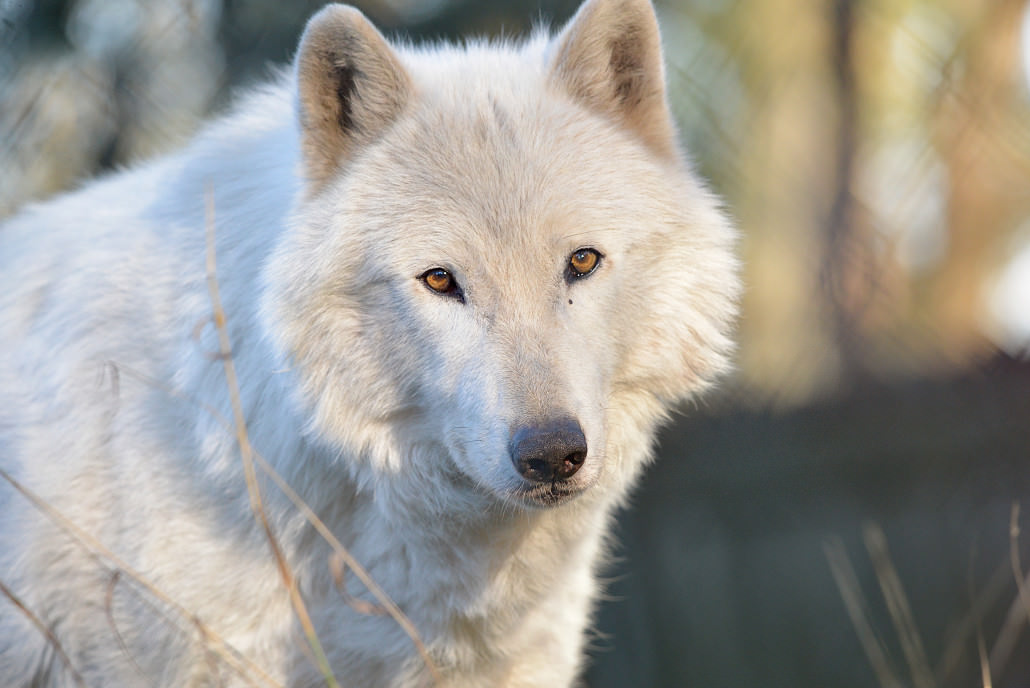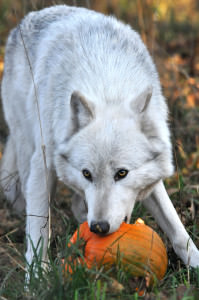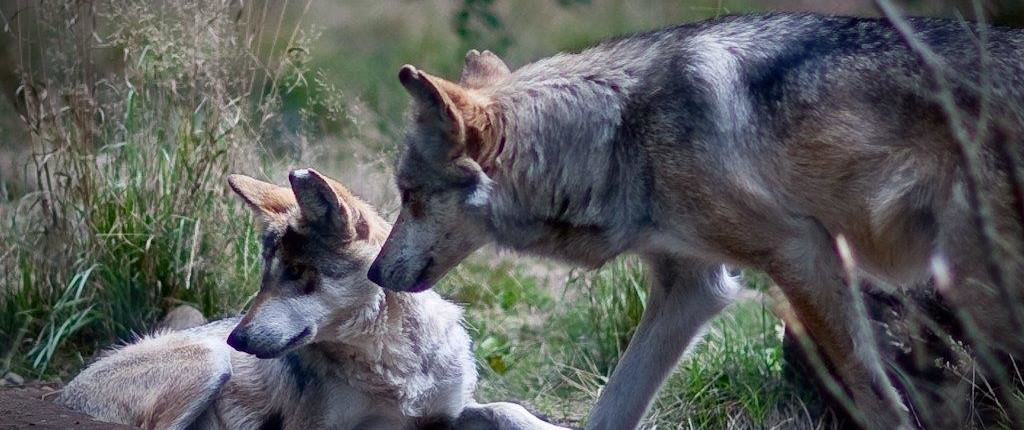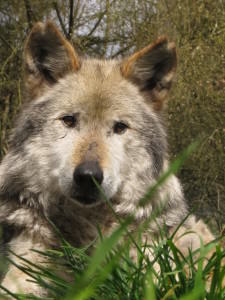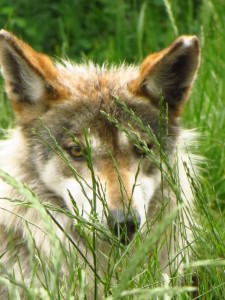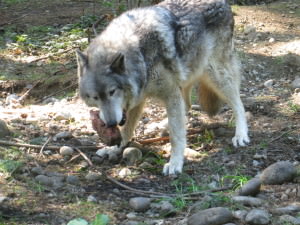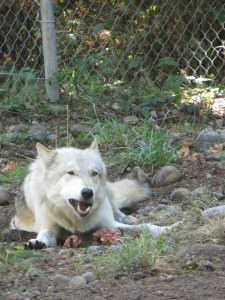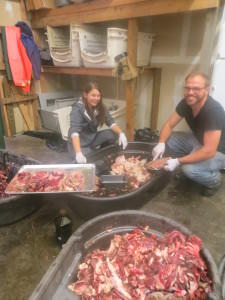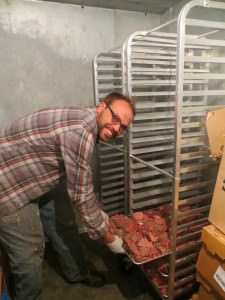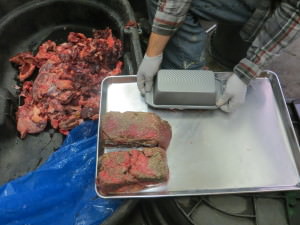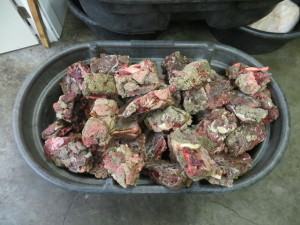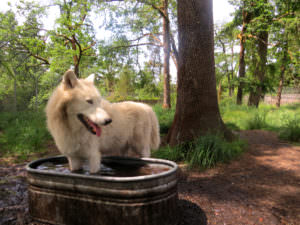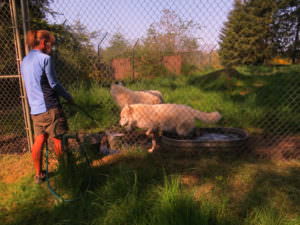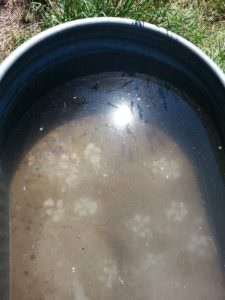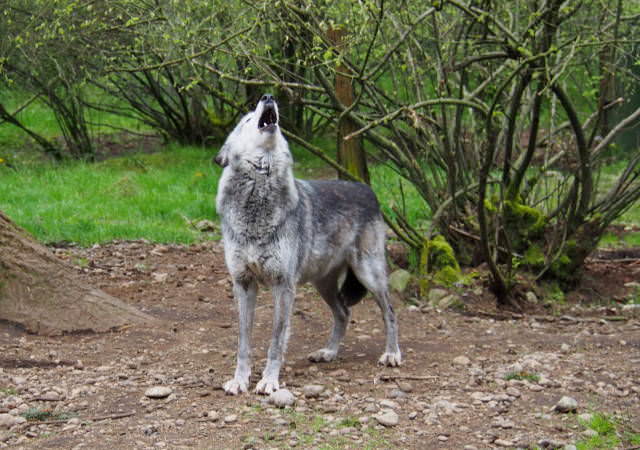Posts
Happy National Volunteer Week!
by Cindy Irwin, Director of Volunteer Services, Wolf Haven International
Wolf Haven volunteers help to create a better world for wolves and people in many ways. Just as the wolf pack depends upon one another for survival, Wolf Haven depends on volunteers to help us accomplish our goals.
Here are some of many activities our volunteers are involved with that support our mission, “to conserve and protect wolves and their habitat”.
• Provide our guests with a chance to see sanctuary animals and learn about wolf behavior
• Get their hands dirty in the ground to help create a beautiful landscape
• Staff information tables that provide additional information about wolf behavior
•Ask for donations to further the work of the sanctuary
• Serve as a board member for Wolf Haven
• Use artistic talents to support our events & fundraisers
• Create unique or smelly “enrichment” for the resident animals
• Guide guests through the prairie so they can learn about the native plants and animals
• Provide information about wolf conservation throughout the community at schools, churches, fairs, and prisons
• Give visitors a memorable experience at our sanctuary
Could you be a Wolf Haven volunteer? Want to learn more? Send an email to Wolf Haven’s Director of Volunteer Services, Cindy Irwin, at cirwin@wolfhaven.org.
Saying good-bye to Spruce
by Wendy Spencer, Director of Animal Care
Saying goodbye to one of our friends is never easy, so it is with a heavy heart I write to let you know that Spruce has passed away.
We have been watching a decline in his condition over the course of the last year and though he had been enjoying relatively good quality of life, we knew that his time would be drawing near. During the morning walk-through the sanctuary on Saturday, March 12, Spruce was not at the front of his enclosure waiting for food like he has been every other day for the last 13 years.
Right away, we knew something was not right. After checking his shelters and still finding no sign of him, we checked his natural den and discovered him lying near the entrance, head poking out but the rest of his body inside. He was alert and responsive but too weak to get himself out. Animal Care staff chemically immobilized him to help him out of his den and since we had him in hand, we took him to the vet for a full diagnostic. Sadly, x-rays revealed fluid in one of his lung fields as well as what appeared to be cancer. Additionally, his other organs did not look healthy and blood work indicated that his liver was shutting down. The kindest thing we could do for our friend was to help him along, so Spruce was humanely euthanized at the clinic without every waking up from anesthesia.
Spruce’s sisters Cricket and Jinkies passed away a few years ago from similar cardio-respiratory conditions, so we suspect there might have been something hereditary in this family. Spruce is survived by three remaining littermates, (Myta, Chai and Bart), who at this point show no signs of any health issues. We are hopeful that whatever afflicted Spruce and his sisters is not present in the rest of the group.
Spruce and his entire family of eight were rescued from private ownership in 2003, when Spruce and his siblings were just seven months old. We have had the honor and privilege of watching him mature into a larger-than-life presence in the sanctuary. He lived most of his adult life on the public visitor route and because of his comfort level around staff and visitors (as well as his stunning looks), he became one of the most photographed wolves in our sanctuary.
Though he slowed down the last few years, Spruce was one of the most vocal and gregarious animals here and because of his antics, he endeared himself to all who had the honor of knowing him. He has left an indelible mark on our hearts and minds. And although it is bittersweet each time I walk by his now vacant enclosure, I cannot help but smile a little as I think of him and the joy of his fullness of being. Rest in peace, friend.
Remembering Wayne

by Cindy Irwin, Director of Volunteer Services, Wolf Haven
“Some people come into our lives and quickly go. Some stay for a while, leave footprints on our hearts, and we are never, ever the same.”
Flavia Weedn
Wolf Haven has lost a cherished volunteer. Wayne Clark Elliott served as a sanctuary guide steadfastly for ten years. With a booming voice, he shared his passion for wolves with thousands of guests from all over the world. Wayne was known by all as an expressive communicator with a very unique sense of humor.
One of the favorite anecdotes he would share with guests was the wolves’ fondness for frozen bloodsicles. With a straight face, he would suggest that visitors pick up their own frozen blood treat in the gift shop at the end of their visit. You could see folks looking at each other, thinking “Is this guy serious?” All the puzzled looks were replaced with smiles when they heard the words“ Just joking!”, in that rich, commanding tone of voice unique to Wayne.
Wayne packed so much information into his wolf tours that he found it difficult to keep it to the prescribed 50 minutes. He simply loved sharing his passion, which successfully led to his goal of dispelling myth and legend about wolves, both captive and wild.

Wayne receiving award at 2015 Volunteer Appreciation
For many of us, there will always be an empty spot where Wayne once was. He was a great teacher and we all looked up to him. Just like the wolves who have passed during the last 34 years, Wayne will never be forgotten. His contribution to wolf conservation has become a permanent legacy at our sanctuary of peace. I would like to think of him now residing in a heavenly place where he may chat about what he loves, without limits. Rest in peace, Wayne.
Meet Gypsy and Diablo, the sweet Mexi duo
by Pamela Maciel, Mexican wolf/bilingual education specialist, Wolf Haven
There are currently 19 Mexican gray wolves living at Wolf Haven International. All are part of a binational Mexican wolf Species Survival Plan (SSP) Program. Of these animals, there is only one pair that sanctuary guests have the opportunity to admire during their guided visit: Mexican wolves M657 and F907 (otherwise known by in-house names Diablo and Gypsy).
All SSP programs were created to save highly endangered species from vanishing permanently by means of building a captive population through selective reproduction planning. Eventually, particular individuals could be potentially released into the wild. Both Diablo and Gypsy were born as part of the Mexican wolf captive breeding program, in 2000 at Detroit Zoological Institute and in 2004 at Río Grande Zoo, respectively. Diablo was transferred to Wolf Haven in 2004 and Gypsy joined him in 2005; ever since they have been sharing an enclosure on the public route.
They are such a cute pair to observe. Even though it isn’t huge, from a physical perspective their age difference has become quite noticeable. Gypsy is an 11-year old that looks like a blooming yearling; her sparkling big eyes and flamboyant coat often make visitors sigh. On the other hand, handsome Diablo’s 15-year old body is showing its natural decline; his movements are at times clumsy, he has lost almost all of his hearing and his sight isn’t that great either. That does not deter him from teaming up with “Gyps” every morning and engaging in enthusiastic displays with all their enclosure neighbors. Beyond the physical differences, their shared self-confident and playful character makes Gypsy and Diablo wonderful life mates as they celebrate ten years of togetherness.
This article originally appeared in the Fall 2015 issue of Wolf Tracks magazine.
Wolf Loaf Redux (or, how to build a better loaf)
by Brennan Stoelb, Animal Care Specialist, Wolf Haven International
It has been almost two years since I last wrote about wolf “loaf.” As you may or may not recall, Wolf Haven is part of a program called Sustainable Solutions. Their goal is to reduce food waste caused by unsold products. By connecting animal facilities like Wolf Haven and food stores, meat that would normally be disposed of in a landfill or a rendering plant can be utilized. Disposing of unsold food items costs the stores money. Animal rescues often have a never-ending need for meat. Through Sustainable Solutions, both party’s needs are met, while cost and waste can be reduced.
Every Friday, two animal care staff hop into our trusty white cargo van, head to a popular food store and collect roughly 800-900 lbs. of scrap meat. This meat ranges from unusable items such as bacon, ham, and other processed meats, to usable steak, chicken, and beef. We do not feed processed meats due to the high fat and sodium content; on average, I would say that half of the meat is usable.
After we sort through the meat, we need to feed it to the wolves efficiently. Originally we made loaf in disposable, paper food trays (like you get French fries in at a fair). We would pack the bottom with ground beef, lay on a piece of chicken, and top it off with a steak. Once formed, each loaf was put in the freezer. This yielded a roughly 2 lb. loaf that was easy to feed and utilized as much of the good meat as possible. When we were ready to feed the loaf, we pulled it from the freezer to defrost and then had to remove the food trays, often stuck to the meat. That was Wolf Loaf; we now enter Wolf Loaf 2.0!
In mid-summer, I began looking at ways to store the loaf better in our small freezer. Meat that we purchase plus the often-present deer carcasses used for feeding take up a lot of space. Add a couple of 50-gallon tubs for loaves, and you’re nearly out of room. A lot of vertical space wasn’t utilized, so a shelf made sense. We purchased two bread carts for storing the loaf, as well as their corresponding metal trays.
We also wanted to get away from using paper food trays. We didn’t like the waste they produced, as well as time (maybe 10 minutes total) lost removing them from the loaf. My previous experience at another wolf facility led us to start using bread pans. We could pack the ground beef, chicken, and steak into the bread pan and turn it over on a tray. We then put the loaf tray on the rack and freeze them. Step two complete!
Feeding scrap beef provided some challenges. When tossing the scrap meat over the fence, pieces inevitably got stuck in the fence, which the person feeding had to dislodge. As good as our throwing arms may be, pieces of meat also got stuck in branches and taken away by ravens. Reducing waste in the form of lost meat was another huge factor.
By combining the donated meat and scrap beef, we can make bigger loaves and go from a 2 lb. loaf to a 4 lb. loaf easily. Feeding 4 lb. loaves twice a week equals 8 lbs. Since we had been feeding 4 lbs. of scrap beef and 2 lb. loaf twice a week, each wolf still gets the same amount of meat.
With all the pieces in place, we are now on our fifth week of feeding the new loaves. This week will be our first time not feeding scrap beef. With this new system, we hope to reduce waste and become more efficient, a plus for humans and wolves!
Splish Splash
by Brennan Stoelb, Animal Care Specialist, Wolf Haven International
In a recent blog I mentioned that it has been hot here in western Washington. Read it here…… While on most hot days the wolves lay in the shade to keep cool, Wolf Haven also provides other means to beat the heat; splash tubs.
For the animals that enjoy wading in water, animal care places 45 gallon, galvanized tanks in their enclosure. Not every enclosure has a tank because, just like humans, not every wolf likes to get wet. The tubs are about a foot and a half tall, just enough to be below their stomachs. They’ll jump in the tub and begin pawing the water to make it splash. Lakota and Shadow are two residents who love their tubs.
As you might assume, all this playing in the tub can make for some messy water. Every week animal care scrubs the tubs and replaces the dirty water with clean. In some cases the water will be changed more frequently. Daily we top-off the tubs to replace any water that’s been splashed out. With sponges and diluted bleach in hand, we go about the task of cleaning. Not only does dirt and fur cloudy up the water, it’s not uncommon to see someone peeing in their tub. Nothing is better than filling a tub with cool, clean water, only to have them hop in and pee – to each his own, as they say. Sometimes during feeding, a piece of meat will fall the wrong way and land in the tub.
One day when I was feeding a treat to Lakota, a piece fell in the tub. Not to let a little water stand in his way, Lakota stuck his head in the water, over his eyes, and sort of “bobbed” for his treat. Unfortunately, he was unsuccessful. I threw him a replacement, which he ate, but he went back to the tub and pawed the surface of the water, ever hopeful that it may float to the surface.
It surprises some people to hear that wolves can swim. They have webbing between their toes to help them move more easily on snow and uneven surfaces. This webbing also helps when swimming. Wolves will cross streams while chasing prey but
photographers captured one young wolf in Canada swimming to catch a goose. Perhaps his “rubber ducky?”
On Lake Superior in northern Michigan there is an island called Isle Royale. Once connected by a predictable ice bridge in the winter, Isle Royale has become a subject of recent debate. Home to a 56 year study on moose and wolf interactions, the island’s wolves are in decline. According to the annual report, there are nine wolves on the island, two of which are female. Scientists are concluding that the decline is a result of inbreeding both in prey and predator, since no new genetics are regularly coming to the island. To get to the island, wolves would have to swim about 15 miles. In 1997, a wolf from Canada affectionately called, “The old grey guy,” crossed the ice bridge and became a successful breeder. The debate amongst scientists is whether humans should intervene by bringing new genes to the island or let nature take its course. For more information on Isle Royale visit www.isleroyalewolf.org.
So if the heat gets to you this summer, do what the wolves do – and take a dip!
A Picture (and Sound) Worth a Thousand Words
by Wolf Haven volunteer Greg Wellsandt
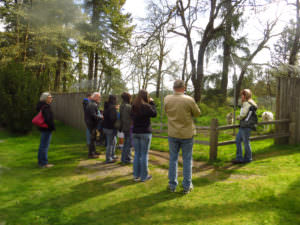
Volunteer Traci leads a group through the sanctuary
On Saturday, Wolf Haven volunteer visit guide Traci was giving the first visit of the day, assisted by her flip chart turner, Greg (that’s me). At Enclosure #5, a howl started way out in the off-visit area. It took a long time to gain momentum, but soon the whole gang was fully engaged in the music making. Caedus and Ladyhawk put on a show at the front of their enclosure as did Klondike and Mehina.
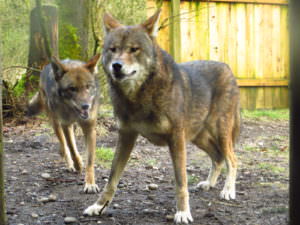
Ruby and Tala, red wolves
Ruby and Tala even made an appearance to lend their unique voices. The howl went on for a long time much to the delight of the visitors who were snapping photos and recording the sounds. Finally, Ladyhawk had enough. She decided it was time to shut Caedus up because she was in the mood to play. She bent over in a quasi-submissive pose and attempted to get his attention. When that didn’t work, she tried to grab his jaw to stop the howling. Caedus gave it a thought for a moment, but went back to what he loves almost as much as eating, howling.
Ladyhawk was not to be deterred and continued to try to get Caedus’s attention. Finally, the howl started to diminish and the two became engaged in a bit of gentle roughhousing. Our sanctuary visitors were treated to a wonderful live display of wolf communication.


